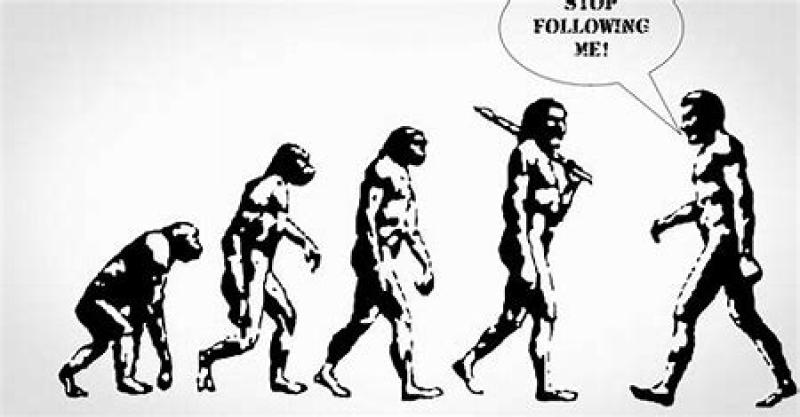Could There Be Design in Evolution?


The theory of evolution has divided our modern culture, but does it have to? Could there be a way to show evolution is compatible with the major religions of today?
I found this video today. In it was expressed concepts I hadn't heard of before and found them very interesting. Especially convergence and the idea that we are not random but rather, possibly inevitable from a scientific standpoint. Doesn't do much for explaining our intelligence, though.
As for Michael Jones, I've been watching a lot of his videos on his site, Inspiringphilosophy . I think he does about the best job I've seen concerning Christian apologetics from a science standpoint. Not all his vids are from a scientific standpoint, though. Some are explaining why what some consider contradictions may not actually be contradictions.
Anyway, I found this video interesting and thought I'd share.
Tags
Who is online
46 visitors

Not trying to get into a discussion about God, here. Don't try to engage me in that way because I won't. Rather, I intend to discuss points brought up in the video. If someone else wants to, with someone else, that's fine by me. That said...
One of the things I've always wondered is, if evolution is simply random, why are there, or have been, no six legged mammals? Why do they all have the same basic body type rather than more variety, such as having six legs? Dinosaurs were pretty successful, yet we don't have mammals that look like velociraptors or T' Rex's. While one may not accept intelligent design, it would appear that the universe imposes constraints, at least.
Just a thought: In evolution, one thing evolves from another, so you have to change the form from one thing to another with a starting point. So, the first mammals had four appendages (plus a tail). To grow from four legs to six, I suppose that you would need a condition to occur that would make six legs better able to thrive and the genetic means of creation of the extra two legs.... seems like quite the jump in morphology, but hey birds came about and I have never seen a winged (or legged for that matter!) stromatopariod.
Makes sense, to a point. However, I can easily imagine that many tree dwelling mammals would find six appendages more advantageous than four. I suppose it could be argued that, if six were more adventageous, we'd see such but, as far as I know, nature never even tried. I find that curious.
If you want to see some exotic biodiversity, check out sea creatures. One of them familiar to us, the octopus, has 8 limbs. Starfish (most of them) have 5.
We do not know that 'nature never tried'. My guess is that nature has indeed 'tried' and has, so far, failed to produce anything that has long term viability.
Is that guess based on anything? That is, is there something in the fossil record you're thinking of?
It is based on the fact that there are all sorts of strange creatures (e.g. sea creatures) which have many limbs. We see insects with many limbs (e.g. spiders). Thus the evidence suggests to me that various limbs (other than 2 or 4) are possible by the laws of nature. Given that 6 limbs is logically possible, I am inclined to think that over 200 million years of evolution (all those generations) that there have indeed been 6 legged mammals that were born. Why this mutation did not provide survival advantage is a great question, but there are all sorts of ways of having 6 legs. (Seems to me that 6 legs makes running rather complicated for a mammal.) I am reminded of birth defects and the unsuitability of those mutations to survival.
And the average octopus is smarter that the average human.
Just saying.
Granted, but I'm not sure anyone would suggest that these mutations were an attempt by nature to create a genetically advantageous adaptation in a species by natural selection rather than a simple, but massive transcription error in the genetic code. Especially since such birth defects obviously do not convey any survival advantage.
And while, generally, there are all sorts of ways of having six legs, I'm speaking about mammals specifically. I find it curious that there is only one body type for mammals. Arranged in different ways, but still one basic body type. The closest departure I can think of from this design that I can think of at the moment would be cetaceans and manatee, but even they have vestigial hind limbs in fetal development, which are subsequently absorbed away later. I would guess that this is not selected by the environment in which cetaceans live, but rather, imposed on them.
The difference between "selected" and "imposed" might seem like splitting hairs to some, but, for myself the difference is a profound way of looking at evolution. Selected, to me, suggests that nature selects for those mutations that benefit the animal in the environment in which it lives. Imposed, to me, suggests that the environment in which an animal lives causes the change, not random mutation.
I am too. Because legs other than 2 or 4 exist elsewhere in nature, I posited that variations are possible in mammals too.
You then should be curious as to why the prevalence of two eyes, two ears, hair, skin, bones, etc. There are all sorts of similarities. And that makes great sense since mammals are all ultimately related. 200 million years ago what we consider 'mammal' was at its evolutionary infancy. Unknown but vast variations on 'mammal' have come and gone and only a relative few variants remain extant. They are quite varied at times but, given they are all mammals, quite similar too.
The scientific explanation (hypothesis actually) for why no 6-legged mammals is not because that mutation never emerged but rather that it likely emerged but never in conditions where six legs offered reproductive advantage. We do not see three-eyed, 20-fingered, quad-nasal, etc. mammals either. Likely for the same reason.
My view is that what we have today is the result of a complex, seemingly-deterministic process that, at this moment in time, on this planet, with these environmental conditions, and based on genetics that have evolved for 3.5 billions years has resulted in certain specific extant species. Something had to result. Let things change (and they will) and at some other point in time (or space) different extant species will likely exist. One can always speculate intent on whatever results. For me, however, intent requires sentience and there is no evidence of sentience.
Same thing. The imposition of the characteristic is due to the environment. The example that was in the video was of creatures coming from different backgrounds but assuming similar forms. These forms are imposed as a result of the physical laws with which a creature has to interact.
My best guess as to why you don't see six legged mammals is that four legged mammals are better able to perform the actions necessary to survive as a species.
Which, to my mind, means evolution is not a random, unguided process.
Think of evolution as a reaction to a stimulus rather than something that's "guided." Kind of like a reflex if you will. An organism encounters an environmental change or stimulus of some kind. It reacts by adapting to that stimulus, resulting in an evolutionary progression. If it cannot adapt, it will likely go extinct. But that is a very simplistic way of explaining it.
You have it backwards, you can spend your whole life on your tippy toes reaching for things on the top shelf and it won't make you or your children any taller. Evolution is a byproduct of mutation and natural selection/survival of the fittest. The mutation happens first and is always completely random and in rare instances when a mutation is beneficial it allows that individual and their descendants who inherit that mutation to survive in greater numbers and reproduce more children than the unmutated version of their species. Then over the course of many thousands of years they must either out compete the unmutated version till they die off or are bred away or the mutated can branch off and become a subspecies. Eventually through interbreeding and more natural selection the mutation can become more pronounced and they can become their own species. Of course dramatic mutation like getting an extra set of limbs is something that only really happens in lower organisms whereas growing taller, walking upright, developing better vision or night vision, or better finger dexterity are much easier evolutionary jumps. When we breed animals we become the "Nature" in natural selection and we've bred every breed of dog from wolves and what we did was select mutations/traits we liked over those we didn't like. We fed and bred the dogs we liked and didn't feed or breed the dogs we didn't like.
Evolution is indeed not random; that is the scientific position as well. But there is no evidence that it is guided other than by the underlying laws of physics. It is, best we can tell, an enormously complex process (over long periods of time) where countless variations arise and fade away filtered by an ever-changing heterogeneous environment. It is a trial & error process that is inherently grossly inefficient — 9x% of its 'trials' fail to produce a viable new species. It also is imperfect in that it produces species with myriad flaws and shortcomings such as our teeth and eyes, Giraffe recurrent laryngeal nerve, the many vestigial parts in extant species, etc. But, in contrast, it is awesome when the trials work to produce things such as the Eagle's eye, the human brain, the wing, the Ape muscle, sonar of the Bat, etc.
Well, realize that I was oversimplifying to make the point and maybe I used poor word choice. And you still need the reason, the niche to fill, some natural condition that the mutation works better in, for that mutation to be preferentially propagated and not just be intraspecies variation. In the case of six limbs, well, that seems like a bit of a stretch for mammals.
Dragons, however, have six limbs...
We are all creatures of our environment.
No.
And hi.
Hi back.
Evolution does seem to have a certain degree of randomness to it, either for good or bad. But it's not entirely "random" either. Evolution does show the result of an adaptive response and subsequent progression of a species. This is made clear when we examine the fossil record. The evolution of homo sapiens from earlier ancestors shows a clear progression of change.
One must take the environment into account. It's been speculated that large mammals may not have evolved had dinosaurs not gone extinct.
Evolutionary stimulus or constraint is based more on the adaptive needs and environmental pressures placed on an organism. Of course, that is also an oversimplification.
The K-T line as well as recent deep sea core drilling in the Gulf of Mexico confirm a large asteroid strike that caused radical global climate change that forever doomed the dinosaurs from ever having a 'dinosaur pets playing poker' painting.
Because all mammals evolved from one common rat like ancestor. If you examine a rats, elephants, horses, cats, dogs, or even a humans legs you find very similar Skeletal structures. Humans of course are the most different because we actually stand on our heels and they are part of our feet while all the rest have wrists and heel joints farther up their legs and their feet are what would be to us fingers/toes and first knuckles. Even Whales and Dolphins evolved from that same line they were a pig like creature when they returned to the sea.
The idea that there is an underlying order to reality is actually one of the foundations of science. Scientists do not hold that evolution, for example, is a random process (Professor Dawkins included by the way) but rather an unpredictably (to us) complex process of mutations and natural selection resulting in vast biodiversity and (importantly) an extremely sparse extant result of all that is logically possible.
Possibly, but I'm not sure that is the right way to think about it. As the video suggests with its examples of convergent evolution, it seems, rather, that nature has something specific in mind when it comes to filling a niche. I can't think of any specific barrier to six limbed tree dwellers and, thinking casually about it, it seems like it would be an advantage, yet we see none. If what the vid purports is true, it would seem that six limbed mammals are not allowed in this environment by design, else I think we'd at least see an attempt somewhere in the record.
Why do you think that evolution has intent? It produces results in a seemingly deterministic process, but why is that viewed as intent? In general science even, is the crystalline structure of every snowflake intended or is it simply the consequence of how the substance of reality interacts?
At the very least this states that not every permutation is viable to survive as a species. That does not surprise me.
Perhaps it's a matter of balance. If such a niche is lacking evolutionary occupancy, then other species will either prosper greater (think invasive species) or suffer detriment (less food sources or such).
One potential barrier might be the greater energy requirements for such an organism to exist and function efficiently. Another might be limited range of motion, as extra limbs might inhibit the movement of others, which can be detrimental when one swings from trees.
It could be possible such an organism did evolve, but quickly went extinct. SO there may not be enough evidence remaining. Of course, evolution may have "stopped" at 4 limbs (arms and legs) as that was sufficient enough for that organism. So there was no evolutionary pressure to evolve more limbs.
What about the pushme-pullyou? What was its evolutionary basis?
Uh, that is a fictional animal. Now, if you said the duck billed platypus, then I might be stumped.
The increased energy requirement was one thing I had considered but that seems like a weak objection for every case. When one looks at the Cambrian explosion, nature appears to have attempted every possible permutation, or so it seems.
I can't say it's for every case. It's at least plausible for some cases. If an organism evolves needing more energy than can be obtained in the environment, then it's likely the organism can go extinct.
Evolution run amok, as it were. It's unclear why there was such a sudden surge of species diversification. There are possible explanations, such as a greater oxygen concentration in the atmosphere and the development of the ozone layer, which enabled land based life to evolve and thrive. It's quite fascinating really.
I submit insects as filling the multilimbed void.
The brain size needed to control a six limbed rat was likely a limiting factor.
Even humans who have developed multi-axle vehicles tend to stick with 4 wheels.
Evolution does seem to be practical if nothing else.
Are we being snobs to insects (6 legs) and spiders(8 legs) and centipedes and millipedes?
LOL, no. It's just that my question was why we don't see more diversity in mammals. We all pretty much share the same general body plan.
Mammals is just a classification of organisms which share similar characteristics. With few exceptions, all mammals share characteristics such as: giving birth to live young and lactating, similar anatomical configuration, the presence of hair, warm-blooded (body temperature regulation), and having unnucleated red blood cells. In that regard, humans are no different than say dog or cats.
If it works, why mess with it? Efficiency seems to be a deterministic factor.
I mean, for a single celled organism, a pseudopod seems to be enough. In insects, one of the distinguishing characteristics is that it has six legs. "Bugs" have many configurations of legs, e.g. the centa and millipede. Maybe they arise from the necessity to support the frame of the exoskeleton?? The presence of many legs may have something to do with the fact of where they are moving about.
Why would anything else be needed if the most efficient method of the extremities had been reached for that particular species?
Except for the eyes. Eyes tell you a lot about the brainpower of an animal. Those who have eyes in the front of their heads are more intelligent than those who have them on the sides of their head. Their brains also work very differently.
I haven't considered eye position to be an indicator of intelligence. Thanks for that.
It has to do with either being a predator or the prey. Eye on sides of the head lets the animal see in two different directions so they can see a predator coming, but their brain is then split and so lower intelligence. Predators need to be able to fixate on the pray and also think about strategy. Their brain works in unison to get the job done. This true of all mammals
There are a few exceptions to this like birds, who actually have a wide span of intelligence from uber low to uber high, yet they have eyes on the side of the head. The difference is whether or not, they are aware of this. You can see this with crows or parrots who actually use one eye to get a better look, while a chicken will not. So it isn't fair to call every stupid thing a "bird brain", LOL!
I wonder how many human beings would fail that test.
I would. I would probably get frustrated in trying to figure it out, that I would go all Neanderthal and start smashing everything.
I think different people have different things they excel at. While there may be X amount of humans that would fail such a test as this, they would, I believe, excel at different types of problems. Speaking for myself, I think I would excel at problems like this, but problems involving social interactions, not so much. Determining the correct course of action in a political situation, for instance.
No, the octopus, is clever, personable and devious.
As a pet shop operator I learned the hard way about trying to keep one captive.
At night s/he would leave remove the covering on her own tank and visit other fish tanks to eat the
appropriate sized sleeping fish, then place the screens or covers back on that tank and return to
the octopus tank closing the door behind her.
It took weeks and borrowed surveillance equipment to catch it in the act.
They can walk, slide around for 30 to 60 minutes, out of water.
What of the Dolphin? Certainly it is considered among the more intelligent species on earth. Some species of whales as well.
Sea mammals who are predators also seem to be an exception.
Carefully trained ones, sure.
Are we assuming they have no hands to simply pick up the box with the treat and dump it out? And that they can only use their lips? If so, I'd say more than a few.
To be fair, they would have to use only their lips and teeth just like the crow. Would be a funny sight to see. Especially if the test subject failed the test.
perhaps god was a genetic engineer.
Genetic Officer of the Day
military people will get the reference "officer of the day"
the missing link in evolution? genetic engineering
The concept of god/s or supreme being/s has been dying out since science has been able to explain much of what used to be considered "god's will".
perhaps god was a genetic engineer.
I explored this concept in a sci-fi book once way back in the day. Wish I hadn't. All it did was help fuel intelligent design idiocies.
What is Intelligent Design?
Synopsis: Michael Behe and Stephen Meyer Explain the Inference to Design MICHAEL J. BEHE AND STEPHEN C. MEYER MAY 10, 2018 INTELLIGENT DESIGN
Intelligent Design = religion masquerading as science. Its pinnacle notion of irreducible complexity has been refuted by science and its claims of being science has been adjudicated in a court of law :
Dr. Kenneth Miller (a practicing Christian by the way), the key expert witness at the trial, discusses the trial, evolution and intelligent design in this interview (and plenty of material from Dr. Miller alone is available to you on the web if you take the time):
Essentially, Dr. Miller argued that Intelligent Design is not scientifically testable and as such does not qualify as science. That, in basic terms, makes it a religion. But he offers a cogent scientific argument that counters the claims of Behe, et.al. who continue to try to prop up ID as science. Here is an 11 minute clip (one of many) addressing irreducible complexity:
... and for those interested, the Crash Course series provides well-structured explanations for sometimes complex subjects. This one deals with the Teleological argument which, in fact, is at the core of this article:
It was apparent that Ma Nature was having a ball experimenting with all kinds of life forms as has been discovered in the Burgess Shale
Saw this and immediately thought of this article.